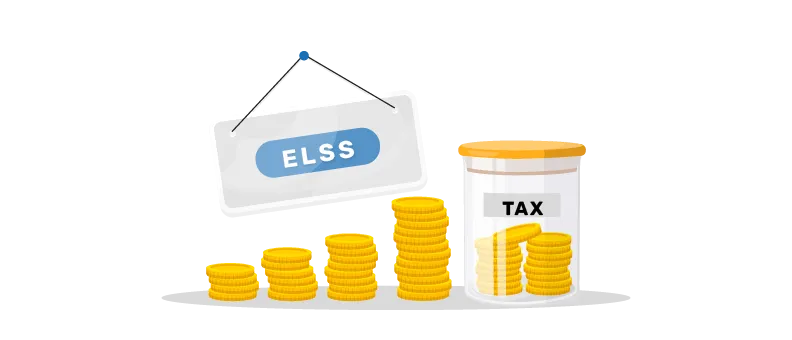Incorporating ELSS funds into your tax saving strategy


Tax planning is an important part of financial planning. It involves identifying the means to legally minimise the tax burden. There are various tax saving instruments available under Section 80C of the Income Tax Act, 1961 that allow you to reduce your taxable income. One such popular instrument is Equity Linked Savings Scheme or ELSS funds. ELSS funds are open-ended equity mutual funds that offer tax deductions under Section 80C, along with growth potential.
With their advantages of tax savings and potential for long-term wealth creation and diversification, ELSS funds can be an integral part of one's tax planning strategy. Read on to explore how to add ELSS funds in a saving strategy and some ELSS fund tax-saving tips.
- Table of contents
- Optimise tax savings with ELSS mutual funds
- Tips for effective tax planning with ELSS funds
- Comparison with other tax saving options
Optimise Tax Savings with ELSS mutual funds
ELSS funds offer tax savings as well as the potential appreciation of wealth over the long run. Under Section 80C, one can claim a tax deduction of up to Rs 1.5 lakh for investments made in instruments such as ELSS funds, Public Provident Fund (PPF), Equity SIPs, etc. Given the benefits, investors should aim to exhaust the Rs 1.5 lakh limit under Section 80C every financial year.
Investing in ELSS funds allows investors to potentially benefit from equity exposure while also achieving their tax savings goal. Thus, allocating a portion of the tax-saving investment amount (or even the entire Rs. 1.5 lakh amount) to ELSS ensures participation in the equity market for long-term wealth creation. One can even choose to invest in ELSS through SIPs for added affordability and convenience.
Tips for effective tax planning with ELSS funds
- Start ELSS SIPs from the beginning of the financial year in April to make full use of the 3-year lock-in period.
- Choose top-performing ELSS funds with a track record of outperforming peers and indices over the long term.
- Redeem capital gains only after the 3-year lock-in period to benefit from lower Long Term Capital Gains tax of 10%.
Comparison with other tax saving options
When compared to traditional tax saving instruments, ELSS funds score higher on return potential in the long run. While PPF offers guaranteed returns of around 7-8% annually, normal fixed deposits provide 4-7% returns.
ELSS being equity oriented, can potentially provide long term returns. This makes a strong case for including equities via ELSS in one's tax planning strategy. However, ELSS investments are subject to market risks.
Other advantages include a shorter lock-in of 3 years compared to 5-15 years or more years for other options like tax saving bank FDs, NPS, PPF etc. This provides some liquidity in case of emergencies.
With the long-term growth expected in the Indian stock market, even conservative ELSS portfolios are likely to generate a higher return potential compared to guaranteed-return instruments. Hence, for investment horizons of over 3 years, ELSS can be a preferred tax saving tool for long term wealth creation through equities.
Conclusion
ELSS funds are suitable for investors seeking to save tax and potentially accumulate wealth over the long term through equity investments. By incorporating ELSS funds into the overall tax strategy using SIPs, investors can optimise the return potential from these tax saving investments. While diversifying with other tax-saving instruments like PPF is possible, the focus should also be on participating in equity upside through ELSS. Thus, with disciplined investments and the selection of the right funds, ELSS can potentially help achieve both tax saving and wealth accumulation objectives.
FAQs
What is the lock-in period for ELSS funds?
ELSS funds have a mandatory lock-in period of 3 years. This means you cannot redeem your investments within 3 years of the date of investment. The lock-in period ensures investors adopt a long term outlook towards their investments and potentially benefit from the compounding effect.
What is the risk profile of ELSS funds?
ELSS funds are equity-oriented mutual funds and hence carry a relatively higher level of risk compared to debt or hybrid funds. The risk associated with ELSS funds is primarily market risk, which means the value of investments can fluctuate with changes in the stock market.
Are ELSS funds suitable for all investors?
ELSS funds can be considered by investors with a moderate to high appetite and a long-term investment horizon. Before investing, investors should be aware of the volatility associated with equity investments as well as the 3-year lock-in period.
Mutual Fund investments are subject to market risks, read all scheme related documents carefully.
This document should not be treated as endorsement of the views/opinions or as investment advice. This document should not be construed as a research report or a recommendation to buy or sell any security. This document is for information purpose only and should not be construed as a promise on minimum returns or safeguard of capital. This document alone is not sufficient and should not be used for the development or implementation of an investment strategy. The recipient should note and understand that the information provided above may not contain all the material aspects relevant for making an investment decision. Investors are advised to consult their own investment advisor before making any investment decision in light of their risk appetite, investment goals and horizon. This information is subject to change without any prior notice.